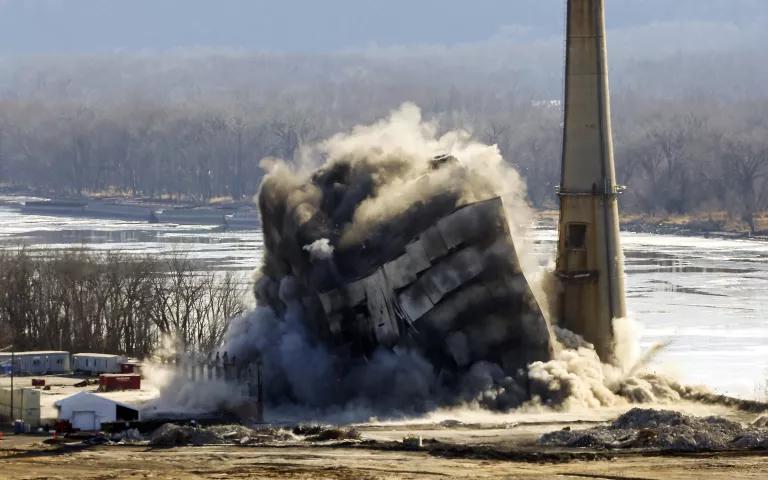Wind and Solar Are the Final Nails in Coal’s Coffin
If you want to know where coal is headed, look no farther than Texas—where this dirty fuel is in its death throes.

Wind farms dominate the landscape in West Texas.
During the 2016 campaign and in various postelection rallies, President Trump promised to save America’s flagging coal industry and put the nation’s coal miners “back to work.” While Trump continues to labor under the delusion that easing emissions standards will somehow resuscitate the coal industry, his administration’s own numbers tell a different story. In fact, more U.S. coal plants have been deactivated in the first two years of Donald Trump’s presidency than were taken offline during President Obama’s entire first term. Domestic coal use in 2018 was also the lowest it’s been since Jimmy Carter was in office.
Cheap natural gas is one reason for coal’s demise, but the more interesting—and much more important—part of the story is the role that renewables, specifically wind and solar, are playing in the protracted fade-out of our dirtiest fuel. As for job creation, the 2018 U.S. Energy and Employment Report found that there are three times as many Americans now working in clean energy jobs as there are in the fossil fuel industry. For quite some time, conventional wisdom has held that renewables pose a serious threat to the future of coal. Now it seems clear the future has arrived.

Just ask the people in my home state of Texas, of all places. In a just-published report, scientists at Rice University in Houston conclude that the state could quit coal cold-turkey today and still have energy to spare—all thanks to recent advances in renewables. As one of the coauthors told the Houston Chronicle, “There is nowhere else in the world better positioned to operate without coal than Texas is. Wind and solar are easily capable of picking up the slack.”
The authors acknowledge that Texas is uniquely equipped to be in this enviable position. Ample winds along its Gulf Coast and in its western plains have helped make Texas the country’s largest producer of wind energy. And its famed size and sunshine have made it one of the fastest-growing states in terms of solar capacity, which industry analysts predict will reach 3,000 megawatts next year—up from just 15 megawatts in 2010.
Where does all of this progress leave coal? Out in the cold. The state’s coal-fired power plants are shutting down or being seasonally mothballed at rates never witnessed before. And according to the Electric Reliability Council of Texas, which provides electric power to more than 23 million Texans, future energy projects in the state are trending—mightily—in favor of wind and solar. One recent chart released by the consortium predicts that these two renewables will generate 86 percent of the megawattage of those future projects. How much coal is in that queue? Precisely 0 percent.
Texas isn’t jumping on the renewables bandwagon out of some official commitment to curb climate change, or because it’s suddenly turned its back on the fossil fuel industry that helped make it an international economic powerhouse. Texas is joining the club for the same reason that so many other states are joining: It makes sound economic sense. As Dan Cohan, one of the Rice study’s coauthors, puts it, “It’s the cheapest way to do things, whether or not you care about the environment.” The new year brought with it a Wall Street Journal story that pithily sums up where things are headed nationally. Under the headline “Utilities Speed Up Closure of Coal-Fired Power Plants,” the article traces the phenomenon in large part to the “more economic alternatives” now provided by wind and solar.
As environmentalists, we’d love for governments, utilities, and energy companies to put climate and air quality at the very top of their priority lists. Happily, more and more are doing just that. But as pragmatists, we should acknowledge that money, in the form of savings and/or profits, is going to be the determining factor in the growth of renewables. The good news is that climate advocacy and renewable technology have combined in such a way as to take the still-young clean energy sector to the next level. As it gets bigger, its products and its infrastructure will get cheaper. And as they get cheaper, dirty coal will look more and more like a loser—even to those who were perfectly fine with it before.
Here’s the thing: As disingenuous as President Trump has shown himself to be, I do believe he’s sincere in his desire to save the coal industry, even if it’s just to shore up votes in Appalachian swing states and appease the corporate fat cats to whom he’s indebted.
The only problem? He can’t do it. It’s too late.
This article was originally published on onEarth, which is no longer in publication. onEarth was founded in 1979 as the Amicus Journal, an independent magazine of thought and opinion on the environment. All opinions expressed are those of the authors and do not necessarily reflect the policies or positions of NRDC. This article is available for online republication by news media outlets or nonprofits under these conditions: The writer(s) must be credited with a byline; you must note prominently that the article was originally published by NRDC.org and link to the original; the article cannot be edited (beyond simple things such grammar); you can’t resell the article in any form or grant republishing rights to other outlets; you can’t republish our material wholesale or automatically—you need to select articles individually; you can’t republish the photos or graphics on our site without specific permission; you should drop us a note to let us know when you’ve used one of our articles.


You Can’t Stop the Wind. But These Folks Are Trying Anyway.
How to Ditch the Biggest Fossil Fuel Offenders in Your Life
A Consumer Guide to the Inflation Reduction Act